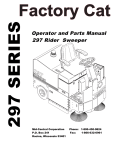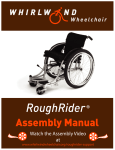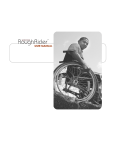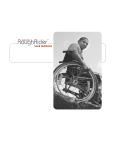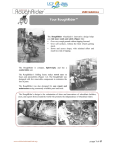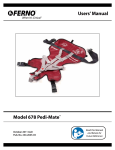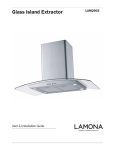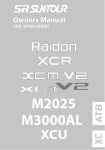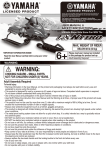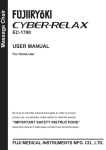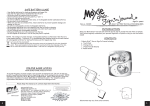Download RoughRiderTM Service Quickstart: Assessment and Order Form
Transcript
RoughRiderTM Service Quickstart: Assessment and Order Form This Quickstart accompanies the Whirlwind Basic Guide to Wheelchair Service and Distribution, which can be found at www.whirlwindwheelchair.org/service RoughRider user group The RoughRider (RR) is most appropriate for riders for whom all of the following statements are true: The rider has: The ability to maintain a sitting position in the RoughRider wheelchair* Good head control 1RVLJQLÀFDQWFRQWUDFWXUHV The following body measurements: Measurement Body Measurement Range Wheelchair sizes Hip Width between 10” and 19” 12”, 14”, 15.75”, 17.5”, 19” Upper Leg Length 17.5” or greater 17” seat depth on 15.75” seat Lower Leg Length 12” to 17” (up to 18” with extra cushion) 10” to 15” adjustable footrest height, plus 2”-3” cushioning Backrest Height support at 12.5” to 16.5” from seat** 14”, 16”, 18” * A RR has a 12 degree seat angle, 90 degree seat-to-back angle with sling seat and sling backrest. ** Extra cushion foam can be used to accommodate longer lower legs and to decrease backrest height. Refer to Whirlwind’s “Guide to Wheelchair Distribution” for assessPHQWRUGHULQJDQGÀWWLQJLQVWUXFWLRQV $WWLPHRIZKHHOFKDLUÀWWLQJUHFRUGÀQDOPHDVXUHPHQWVRIZKHHOchair setup in User Manual. Acknowledgement of Assessment Date: _______ Rider’s name _______________________ Rider’s Signature_____________________ Evaluator’s name_____________________ Evaluator’s Signature__________________ Acknowledgement of Fitting Date: ___________ (Rider) I grant permission to Whirlwind Wheelchair to use and publish my photograph for (optional) &OLHQWÀOH Closed-door-conference Public images Rider’s name _______________________________ Rider’s Signature____________________________ (Evaluator) I grant permission to Whirlwind Wheelchair to use and publish my photograph (optional) Evaluator’s name_____________________________ Signature___________________________________ Whirlwind Wheelchair Updated 17-May-10 San Francisco State University :: 1600 Holloway Ave, SCI 251 :: San Francisco CA, 94132 USA :: http://whirlwindwheelchair.org +1 415 338 6277 RoughRiderTM Service Quickstart: Assessment See Whirlwind Screening and Assessment Materials: www.whirlwindwheelchair.org/service 1. Head Control When sitting in a chair with a backrest, can the rider independently hold up and move his/her head? If no, the RoughRider is not likely an appropriate chair for this rider. 2. Maintain Sitting Can the rider independently maintain upright sitting in a standard chair with a backrest? If no, the RoughRider is not likely an appropriate chair for this rider. 3. Contractures Are there contractures in hips or knees that would prevent the rider from sitting comfortably in the RoughRider wheelchair? (Contractures: Tight muscles that have become VKRUWHQHGDQGPDNHLWGLIÀFXOWWRPRYHWKHMRLQWIf yes, the RoughRider is not likely an appropriate chair for this rider. 4.Sensation Does rider have full sensation at seat surface? Incomplete sensation increases the likelihood of pressure sores. Yes: the rider will receive a comfort cushion. No: the rider will receive a pressure relief cushion. A: Hip Width A: Hip Width 3RVLWLRQWKHULGHUVLWWLQJZLWKWKHSHOYLVXSULJKWRQDÀUPVXUIDFH Measure the distance between the widest points of the hips or thighs without compressing any tissue. Record this measurement. Select seat width using the following chart. The Whirlwind RoughRider Distribution Guide explains pressure sore risk. Risk of Pressure Sores Chair Width Prescription High Risk and/or bony hips At least Hip/Thigh Width + 1/2” (refer to Service Guide) Low Risk At least Hip/Thigh Width For riders with extra hip width As narrow as comfortable without causing high pressure B: Seat Depth B: Seat Depth/ Upper Leg Length :LWKWKHFOLHQWVLWWLQJXSULJKWRQDÀUPVXUIDFHPHDVXUHWKHGLVWDQFHIURPWKHEDFNRI the pelvis to the back side of the lower leg (the back of the knee). Record this measurePHQW6XEWUDFWµWRÀQGWKHPD[LPXPVHDWGHSWKWRDOORZIRUVSDFHEHWZHHQWKH knee and seat fabric. Record seat depth. C: Lower Leg Length :LWKWKHULGHUVLWWLQJRQDÀUPVXUIDFH wearing the footwear they will be using, measure the distance from the bottom of the foot to the underside of the front of the thigh. ReFRUGWKLVPHDVXUHPHQW6XEWUDFWµIRUWKHFXVKLRQWRÀQGWKHGHVLUHGOHQJWKEHWZHHQ the seat upholstery and the footrest. The footrest height can be adjusted when the ZKHHOFKDLULVÀWIRUDULGHU D: Backrest Height Generally the top of the back support should be located just below the bottom of the shoulder blade. For less active riders needing more trunk support, the back support FDQEHFORVHWRWKHOHYHORIWKHDUPSLW)LQGWKLVKHLJKWE\XVLQJ\RXUKDQGVKHOGÁDWWR measure the lowest place on the riders back where he or she is comfortably supported. Measure from the seat surface to the point on the back that is most appropriate for this rider. To determine the wheelchair backrest height, add 1” for the compressed cushion that the rider will be using. Whirlwind Wheelchair C: Lower Leg Length D: Backrest Height Updated 17-May-10 San Francisco State University :: 1600 Holloway Ave, SCI 251 :: San Francisco CA, 94132 USA :: http://whirlwindwheelchair.org +1 415 338 6277 RoughRiderTM Service Assessment and Order Form Date Rider Name Rider Age Rider Gender Rider Reference # Rider contact information Distributing Organization Assessment performed by Yes No 1. Rider has head control 2. Rider can maintain upright sitting position 5LGHUGRHVQRWKDYHVLJQLÀFDQWFRQWUDFWXUHV 4. Rider needs pressure relief cushion Notes on Pressure management: _________________________ If any of the answers for questions 1-3 are“No” in the grey boxes, the RoughRider may not be appropriate for this rider. A: Hip Width Rider Hip Width: Wheelchair Width 12” 14” 15.7” 17.4” 19” D Hip Width A B: Seat Depth /Upper Leg Length Rider Upper Leg Length: Seat Depth on Wheelchair 17” (upper leg lengths greater than 17.5”) B C C: Lower Leg Length Rider lower leg length: 10” to 15” height range from footrest to seat fabric, plus 2” additional height from the cushion (12” to 17”). Optional: Add up to 2” of extra foam. D: Backrest Height Record where backrest should contact rider’s back: $GGµIRUFXVKLRQLQJWRÀQGEDFNUHVWKHLJKW Wheelchair Backrest Heights: 14” 16” 18” Whirlwind Wheelchair Backrest D Height Upper Leg Length B Lower Leg Length C Updated 17-May-10 San Francisco State University :: 1600 Holloway Ave, SCI 251 :: San Francisco CA, 94132 USA :: http://whirlwindwheelchair.org +1 415 338 6277 RoughRiderTM Service Quickstart: Fitting Cushion Check Sensation Level. (See Whirlwind Service Guide.) Riders without full sensation at seat surface should use a pressure relief cushion. The cushion should be about 1/2” wider than the seat width, to hold the cushion in place in the chair. The rider should sit RQWKHLUFXVKLRQIRUWKHQH[WÀWWLQJVWHSV Seat Width Check that the seat width is appropriate for the rider (no more than Grade 1 pressure on the hips, see Whirlwind’s Cushion Fitting Guide). Seat Depth Check that the front of the seat fabric is not pressing on the back of the rider’s legs, when the legs are tucked back as far as they will be allowed (check the calf strap). Look for a minimum of 1/2” gap (1 1/4” is preferable). Footrest Height With the rider sitting in the chair wearing the footwear they will be using in the chair, place one hand under the lower thigh (closer to the knee) on the cushion and one KDQGKROGLQJWKHVROHRIWKHIRRWZLWKWKHIRRWUHVWÁLSSHGRXWRIWKHZD\)LQGWKH optimal height of the foot where there is moderate pressure under the thigh, where WKHIRRWLVQRWKDQJLQJDQGERWKIRRWDQGWKLJKEHDUDSSUR[LPDWHO\HTXDODPRXQWV of weight. Adjust the footrest height by loosening the footrest clamp bolt and raise or ORZHUWKHIRRWUHVWXQWLOWKHZHLJKWRIWKHIRRWDQGORZHUWKLJKRQ\RXUKDQGVDUHHTXDO ,IWKHIRRWUHVWVFDQ·WEHDGMXVWHGORZHQRXJKDGGH[WUDIRDPXQGHUWKHFXVKLRQDIWHU considering the drawbacks (see Service Guide). Backrest Height &KHFNWKDWWKHEDFNUHVWVXSSRUWVWKHULGHU·VEDFNÀUVWVXSSRUWLQJWKHULGHU·VWUXQNDQG secondly allowing pushing on the handrims. Check the backrest height again later if FXVKLRQKHLJKWLVFKDQJHGLQWKHÀWWLQJSURFHVV Pressure Relief Cushion Adjustment (if needed) Evaluate pressure on seat surface, and add additional cutout layers under the cushion RUFDUYHDZD\IRDPZKHUHQHHGHG6HHFXVKLRQÀWWLQJJXLGHRQWKHIROORZLQJSDJHV Rear Axle Adjustment Adjust the position of the rear wheels to meet the rider’s needs; a forward position increases the rearward tippiness of the chair, but makes the chair easier to push and use in rough terrain. Rider Orientation to Wheelchair A wheelchair rider should train new riders and attendants in independent and assisted skills including moving in the chair, the use of parking brakes, transfers, pressure management, wheelies and leaning for rough terrain, and managing curbs and steps. Additional topics are maintenance, cleaning, repairs, and wheelchair adjustments LQFOXGLQJIRRWUHVWDQGUHDUD[OHSRVLWLRQ$JDPHRI´IROORZWKHOHDGHUµRYHUPL[HG terrain helps riders learn and teach each other riding skills. Check Comfort Ask about comfort and feel for high pressure grades after a half hour of use, and make adjustments if needed. 7KLVLVDFULWLFDOÀWWLQJVWHS Whirlwind Wheelchair Updated 17-May-10 San Francisco State University :: 1600 Holloway Ave, SCI 251 :: San Francisco CA, 94132 USA :: http://whirlwindwheelchair.org +1 415 338 6277 RoughRiderTM Service Quickstart: Cushion Fitting Guide For riders with full sensation DWVHDWVXUIDFHDFRPIRUWFXVKLRQPD\EHDGHTXDWH 7KHFXVKLRQVKRXOGÀWWKHFKDLUZLGWKDQGVHDWGHSWK7KH:KLUOZLQGFRPIRUW cushion is 2” of foam covered in a water-resistant fabric cover. The comfort cushLRQOLIWVWKHULGHUDSSUR[LPDWHO\µRIIWKHVHDWVXUIDFHLQWKHUHDUDQGµRIIWKH seat surface in the front of the chair. Riders without full sensation at seat surface should use a pressure relief cushion. Comfort cushion 7KHIROORZLQJLQIRUPDWLRQFDQEHXVHGWRFXVWRPL]HWKHÀWRID:KLUOZLQGSUHVVXUH relief cushion. The Whirlwind pressure relief cushion has optional sub layers and an optional plastic layer, between the top foam and the base foam. Include the SODVWLFLIWKHFXVKLRQLVOLNHO\WRIUHTXHQWO\FRPHLQFRQWDFWZLWKXULQHEXWEHVXUH WRVSHQGH[WUDWLPHHGXFDWLQJDERXWPRLVWXUHDVDFDXVHRISUHVVXUHVRUHV Coccyx Cushion cover not pictured Ischial tuberosities Top Layer Base Layer Greater trochanters Sub Layer 1 Sub Layer 2 Layers of a Whirlwind Pressure Relief Cushion Pressure Sore Risk Areas Check Pressure Grades: Adjust footrests (see Fitting Guide). 'HWDWFKWKHERWWRPVWUDSRIWKHEDFNUHVWIDEULFRQWKHZKHHOFKDLUDQGDGMXVWWKHIRRWUHVWVWRÀWWKH rider while sitting on a pressure relief cushion. Ask the rider to sit back on your hand(s) in the wheelchair. )LQGHDFKRIWKHULVNDUHDORFDWLRQV,VFKLDOWXEHURVLW\JUHDWHUWURFKDQWHU&RFF\[ZLWK\RXUÀQJHUV 7KHULGHUVKRXOGWKHQSODFHKLVRUKHUKDQGVRQWKHLUOHJVIDFHIRUZDUGDQGUHOD[LQWRDQDWXUDODQG comfortable sitting posture. Evaluate the pressure grade using the chart below, and modify the cushion if needed (see Fitting Guide). Replace the backrest fabric as it was. The fabric should be tight when the chair is open, but not so tight as to pull the sidesframes of the chair together or to prevent the seat fabric from being opened fully. The strap/webbing should pass through the buckle three times (see photo below). Pressure Grade Pressure Test Indication Grade One <RXFDQZULJJOH\RXUÀQJHUVHDVLO\ Grade Two <RX FDQ·W ZULJJOH \RXU ÀQJHUV EXW If there is Grade Two pressure at one of the risk locations you can remove them easily. and several risk conditions (history of pressure sores, moisture, heat, shearing or active sliding, low muscle mass, older age) are present, make a change to the cushion to reduce the pressure at that location. Grade Three It is hard to remove your hand and Grade Three pressure at one of the locations at risk will \RX FDQ IHHO UHVWULFWHG EORRG ÁRZ UHTXLUH WKDW WKH FXVKLRQ EH DGDSWHG WR UHGXFH WKH WRWKHWLSVRI\RXUÀQJHUVDIWHU pressure at that location. seconds. Check pressure grade sitting in the wheelchair, with an appropriate cushion Whirlwind Wheelchair Grade One is safe for most people. Incorrect and correct fabric buckle lacing Updated 17-May-10 San Francisco State University :: 1600 Holloway Ave, SCI 251 :: San Francisco CA, 94132 USA :: http://whirlwindwheelchair.org +1 415 338 6277 RoughRiderTM Service Quickstart: Cushion Fitting Guide (continued) Modifying cushion :KLUOZLQGSUHVVXUHUHOLHIFXVKLRQVZLOOFRPHZLWKH[WUDEDVHOD\HUVZKLFKFDQEHSRVLWLRQHGXQGHUQHDWKWKH base foam to provide additional cutout for the Iscial Tuberosities (ITs) by lifting the rider up to create more depth for the rider’s tissue to be supported. Add layers and check for pressure again. If there is still grade two or three pressure present, modify the cutout shape in the base foam by removing (carving with a knife) a little material at a time around the area of high pressure. If pressure cannot be resolved with these simple solutions, refer to a practitioner with further training and instruct the rider to do longer pressure reliefs more often as well DVIUHTXHQWVNLQFKHFNV If there are any active or recently healed pressure sores, remove some material (approximately 0.5”) below that area. After selecting the number of foam layers to use and further carving the foam if necessary, place a plastic cover between the top layer and base layer (if needed), and enclose the cushion in its cover. The pleats in the cover, the closure system, and the cutout should be at the back of the cushion. Carve areas of high pressure if needed. Use additional layers under base foam if needed Replace base foam (in plastic if needed), in cushion cover Using extra cushions to accommodate longer lower leg length: If the rider has a long lower leg length that cannot be accomodated by the RoughRider wheelchair without additional cushioning, add additional foam underneath the cushion to lift the rider higher off the seat fabric. This foam can be placed inside the cushion cover and underneath the base foam, as long as it does not VWUHWFKWKHWRSIDEULFRIWKHFXVKLRQFRYHU5DLVLQJDULGHUZLWKH[WUDIRDPZLOOLQFUHDVHWKHWLSSLQHVVRIWKHFKDLU DQGPDNHLWPRUHGLIÀFXOWWRÀWNQHHVXQGHUWDEOHV $SSUR[LPDWHHOHYDWLRQJDLQVRIFRPSUHVVHGFXVKLRQVDWEDFNRIFXVKLRQ Cushion Type Comfort Cushion Foam pressure relief cushion without sub-layers Foam pressure relief cushion with 2 sub layers Additional 2” of foam lift under cushion No Cushion (sitting on sling seat) Whirlwind Wheelchair Back Elevation from seat 1” 3/4” 1 1/2” adds 1 1/2” elevation µEHORZÁDWVHDW Front Elevation from seat 2” 1 1/2” 2 1/4” adds 1 1/2” elevation µEHORZÁDWVHDW Updated 17-May-10 San Francisco State University :: 1600 Holloway Ave, SCI 251 :: San Francisco CA, 94132 USA :: http://whirlwindwheelchair.org +1 415 338 6277 RoughRiderTM Service Quickstart: Rider Orientation $QH[SHULHQFHGZKHHOFDLUULGHUVKRXOGRULHQWQHZULGHUVWRWKHLUZKHHOFKDLURQFHWKH\KDYHEHHQSURSHUO\ÀW Play a game of “follow the leader” to practice riding skills, and include attendants in the training. See the Whirlwind Basic Guide to Wheelchair Service and Distribution, at www.whirlwindwheelchair.org/service Rider orientation Topics Wheel-locks/Brakes Transfers (in and out of chair) Independent and assisted To/from chairs 7RIURPWKHÁRRU Leaning Moving the Wheelchair Forward, Backward, Turning Uphill, downhill Wheelies, curbs Pressure Management $[OH3RVLWLRQ Transporting Wheelchair Attendant Training Transfers Up/Down Curbs Up/Down stairs Maintenance Cushion Care Cleaning Tires Parking Brakes Repair Whirlwind Wheelchair Updated 17-May-10 San Francisco State University :: 1600 Holloway Ave, SCI 251 :: San Francisco CA, 94132 USA :: http://whirlwindwheelchair.org +1 415 338 6277 RoughRiderTM Service Quickstart: Basic Problem-solving Problem Possible Solution Hips sliding forward Put a cushion between the rider’s back and the backrest if the seat is too long. Tie or velcro the cushion to the seat if the cushion is sliding. Trunk falls forward Use up to 1/2” cushioning behind the rilower back and under to help rider’s torso to recline farther into the sling backrest. Use a more supportive seating system. Trunk falls to side Is wheelchair too wide? A narrower wheelchair will help. Use up to 1/2” cushioning behind the rilower back and under to help rider’s torso to recline farther into the sling backrest. Use a more supportive seating system. 'LIÀFXOWWRVHOISURSHO Is a narrower wheelchair possible? Is rider sitting on enough cushioning? Could the rider propel with one leg? Can an assistant help rider practice riding skills? 0RYHWKHZKHHOD[OHVIRUZDUG Improper leg position Adjust footrests and calf strap for better leg and foot support. Build or cut contour abductor (foam between knees) or Adductor (foam outside of knees) into cushion with foam to position knees. Gap between foot and footrest Raise footrest height to lightly support foot. Add blocks/raises to footrest if the footrest cannot be raised enough. Front of thigh is not supported by cushion Lower footrest. ,IQHHGHGLQVHUWH[WUDIRDPXQGHUQHDWKFXVKLRQ Seat fabric presses back of knee Tighten back fabric. Put a cushion between the backrest and rider’s back to PRYHWKHULGHUIRUZDUGDQGDGMXVWWKHD[OHSRVLWLRQIRUZDUG Wheelchair is tippy backwards 0RYHWKHZKHHOVEDFNZDUGRQHD[OHSRVLWLRQ Beginner riders: balance point of a wheelie holds caster wheels 7”-9” high. ([SHULHQFHGULGHUVEDODQFHSRLQWRIDZKHHOLHKROGVFDVWHUZKHHOVµµKLJK Whirlwind Wheelchair Updated 17-May-10 San Francisco State University :: 1600 Holloway Ave, SCI 251 :: San Francisco CA, 94132 USA :: http://whirlwindwheelchair.org +1 415 338 6277








